
|
Cleveland's Public Square is as old as the city itself. Laid out in the 1790's it was modeled on the common grazing areas that were a signature of New England towns of the time. Over the following century Public Square evolved into the heart of Cleveland's business district and a major transportation hub. The very first horse-drawn, wood rail streetcar line was established in 1834, but was out of business by 1840. Horse-drawn streetcars returned in 1859, and the first successful electric streetcar circled Public Square in 1889. The multiple competing streetcar companies serving the city merged over the years, finally consolidating into the single Cleveland Electric Railway in August 1903. By that time seven different interurban lines had also converged on the square, connecting Cleveland with other cities such as Akron, Ashtabula, Lorain, Elyria, Norwalk, Toledo and Detroit. The Union Depot railroad station and the steamship docks were also nearby, only a short walk or streetcar ride from the square. In the period Cleveland's Public Square was considered by some to be the greatest place in the nation for watching streetcars due to the sheer volume of cars and the number of interurban lines. Interurban Stations The early ticket office for interurbans was a small stand in a hallway just inside the west entrance of the Williamson Building at 6 Public Square. Later, tickets for passenger steamships were also sold here. There was no waiting room other than the small "public comfort stations" on the square were the cars stopped. In 1904 the interurbans moved their ticket office to a storefront at 47 Public Square, on the southwest quadrant. The commodious new station included a comfortable waiting room and baggage and package check service. This area, known as the loft district, was in serious commercial decline by 1910. The more prestigious businesses had moved to Euclid Ave. and the increasingly crowded, decrepit, and dirty buildings on the southwest side of Public Square had become an eyesore. Plans were being floated by a pair of developers to raze the loft district buildings and erect a large union station for all interurbans and streetcars, but it would be many years before this plan came to fruition in a different form. In 1916 the Lake Shore Electric and the Cleveland Southwestern moved to a new station at 25 Public Square, a storefront in the American Trust Building (later to be renamed the Ulmer Building and then the Public Square Building.) Given the number of riders and the rising fortunes of the LSE at the time, the station was surprisingly small; so small it is nearly always obscured in photos or blends in completely among the other shops. The waiting room was bare except for a few benches and a ticket window. The LSE used a relatively standard procedure for its passenger service in downtown. Between scheduled runs limited or express cars would layover at the East 9th Street Pier or the Eagle Ave. freight terminal. At departure time they followed East 9th Street to St. Clair and Ontario, snaking through the tight curves of Public Square to arrive in front of the station. Passengers boarded and luggage was loaded in the street. The cars would then turn west on Superior and cross the Cuyahoga River. West 3rd Street, one block west of the station, was also used as a layover track, usually for local cars which left the station on a more frequent schedule, but photos also show limited cars here. It was also an unloading location for passengers arriving in Cleveland, and a connection between interurbans carrying mail and Postal Service trucks. Cleveland Union Terminal Cleveland real estate (and soon to be railroad) barons Oris P. and Mantis J. Van Sweringen first floated the idea of a railway terminal on Public Square in 1909. The brothers were in the process of planning a rapid transit line to connect their exclusive Shaker Heights neighborhood with Public Square. As they bought up loft district property the plan evolved from a stub-end rapid transit station into a major steam railroad and interurban termainal, a true hub for all rail traffic in and out of Cleveland. Separate concourses, platforms and even rapid transit style private right-of-way access were to be provided for the interurbans. Naturally electric railway officials enthusiastically supported the plan. The LSE, for example, would be afforded right-of-way alongside the Nickel Plate railroad from Rocky River to Public Square, bypassing the slow street route through Lakewood and Cleveland (where no stops were made) and significantly increasing the speed of service. Ground breaking for the Cleveland Union Terminal occurred on March 5, 1920. The enormous project involved the demolition of 2200 buildings, the relocation of 1500 people, construction of new bridges, realignment of railroads, and massive excavations claimed to be second only to the Panama Canal. Unfortunately, as the terminal was built and the tower rose skyward over the next several years the fortunes of the interurban lines were falling. By 1926 the Cleveland & Eastern and the Cleveland, Painesville & Eastern were gone. The Cleveland, Southwestern & Columbus was in receivership and would disappear in 1931 followed by the Northern Ohio Traction & Light in 1932. When the Cleveland Union Terminal was officially dedicated on June 28, 1930 only the Lake Shore Electric showed any real signs of life, and would itself enter bankruptcy in January 1933. Despite the obvious advantages of a rapid transit entrance to Public Square, which may have helped the LSE survive longer, the funds simply were not available to build a new interchange and pay rent to the Union Terminal Company. The LSE had no choice but to continue using the slow street route, passing the glorious new terminal on its way to the tiny storefront station. End of the LSE The LSE struggled on under bankruptcy, but in 1937 the final decision was made to replace electric interurbans with buses and the necessary corporate and legal arrangements were begun. Buses from the Lake Shore Coach Co. arrived to augment the electric cars on routes from Cleveland to Lorain, Sandusky, and Toledo. On May 14, 1938 LSE car 174 made the last Toledo express run with only a few passengers aboard - a trip that had once filled two and even three car trains. Car 167 made the very last passenger run, leaving Public Square for Lorain at 12:41 AM on May 15, 1938. For the next ten years the storefront was headquarters for the Lake Shore Coach Co. In 1990 the Public Square Building was demolished to make way for the Ameritrust Tower, which itself was cancelled before construction began. Today the site is a parking lot awaiting new construction. Cleveland Union Terminal endured (although its use as a railroad terminal ended in 1973) and the Terminal Tower has become a cherished symbol of the city. From the opening of the terminal in 1930 the Shaker Heights rapid transit used the east traction concourse as its Public Square Station. The west traction concourse, intended for the Lake Shore Electric and Cleveland Southwestern, sat empty and unused until 1955 when the Cleveland Transit System opened its crosstown rapid transit service to West 117th Street (today's "red line.") In 1975 the Shaker Heights Rapid Transit and Cleveland Transit System were merged into the Greater Cleveland Regional Transit Authority (RTA). In 1990 the original traction concourses in the terminal were demolished and a new Public Square Station built during renovations for the Tower City Center shopping mall. Thus the last traces of the interurban era disappeared from Public Square. |
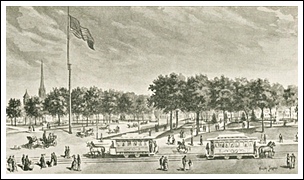
horse drawn streetcars. (Cleveland State University) |

Public Square was at the time. (John A. Rehor) |
|

(Karel Liebenauer) |
|

Lorain & Cleveland ticket office was in the building at far right from 1897-1902. (Cleveland State University) |
|

Building of Cleveland Union Terminal is now at this site. (Thomas Patton) |
|

1916, would become the site of Cleveland Union Terminal. (Cleveland State University) |
|
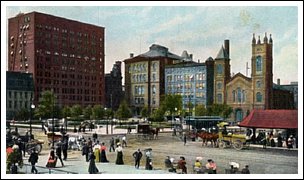
home of the LSE station, on the northwest quadrant of Public Square. (Cleveland State University) |
|

is visible in this 1934 photo. (Dennis Lamont) |
|

The streetcar at the bottom left is stopped near the new station. (Library of Congress) |
|

Shore Electric is marked with a "9". (Dennis Lamont) |

downtown Cleveland. (Victor G. Wagner) |

the shared Public Square station in 1924. (John A. Rehor) |

Square (opposite the LSE station) for unknown reasons. (Dennis Lamont) |

the E. 9th St. pier to Public Square in 1933. (Dennis Lamont) |
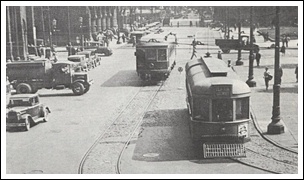
to a Clifton Blvd. streetcar. (Thomas Patton) |
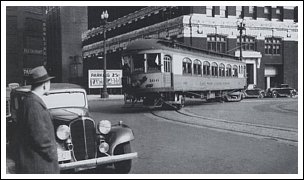
wood combine 166. (Dennis Lamont) |

chartered railfan trip. (Drew Penfield) |

three car Detroit limited train in 1923. (George Krambles) |

ready for boarding at the station in 1938. (Dennis Lamont) |
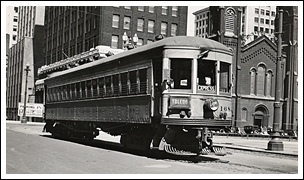
prepares for an express run to Toledo. (Drew Penfield) |

(Harry Christiansen) |

the station in 1936. (Ralph A. Perkin photo) |
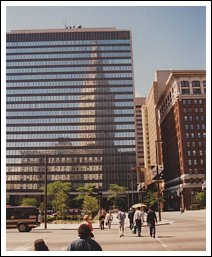
(Drew Penfield photo) |

the station, April 14, 1938. (unknown collection) |

at Superior and W. 6th Street. (Thomas Bailey) |

in 1924 as a third car approaches. (Corman E. Moore) |
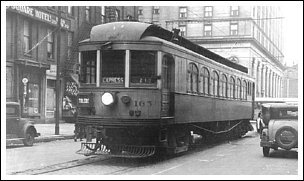
(Bill Volkmer) |

toward the station in the 1930's.(Harry Christiansen) |
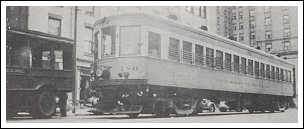
Street in 1938. (Harry Christiansen) |

that express cars used W. 3rd as well as locals. (Tom Bailey) |

(Dennis Lamont) |

inside Cleveland Union Terminal. (Cleveland State University) |

Terminal. (Cleveland State University) |

used by the Shaker Heights rapid. (Dennis Lamont) |

continues in front of the new Union Terminal. (Dennis Lamont) |

bridge under recently completed Union Terminal. (Cleveland State University) |

Terminal Tower looming in the background. (Ralph A. Perkin photo) |

Terminal the LSE will never get to use. (Franklyn P. Kellogg photo) |

being used by RTA in 1978. (Robert E. Pence) |
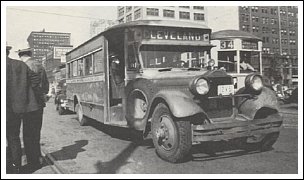
service from Public Square in early 1938. (Harry Christiansen) |

on May 14, 1938. (Harry Christiansen photo) |
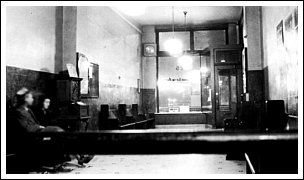
interurban run. (Harry Christiansen photo) |

after midnight, May 15 1938. (Bruce Triplett photo) |

after the switch to bus service. (Dennis Lamont) |

been replaced by Lake Shore Coach Co. buses. (Bruce Young) |

in 1990. View is to the east. (Frank Gerlak) |

from Terminal Tower observation deck. (clevelandskyscrapers.com) |
|
|
|